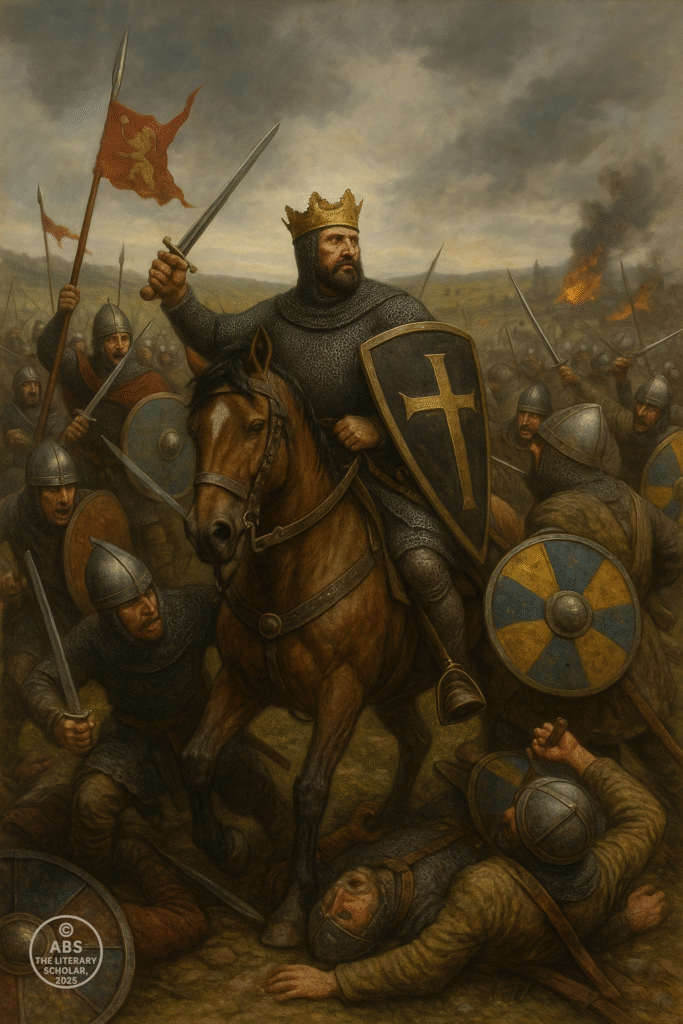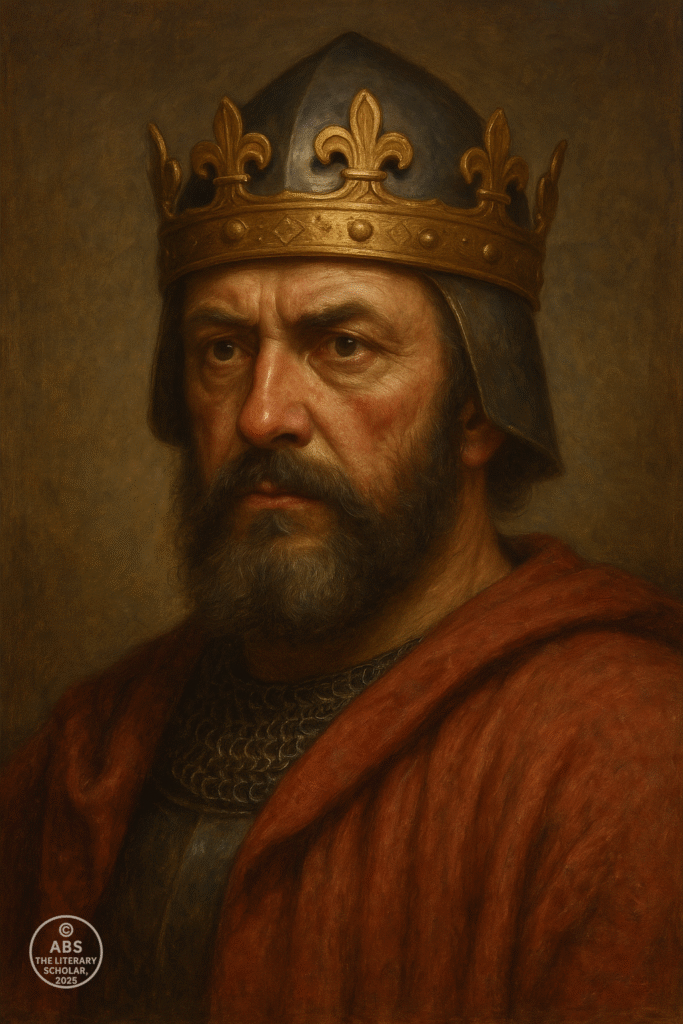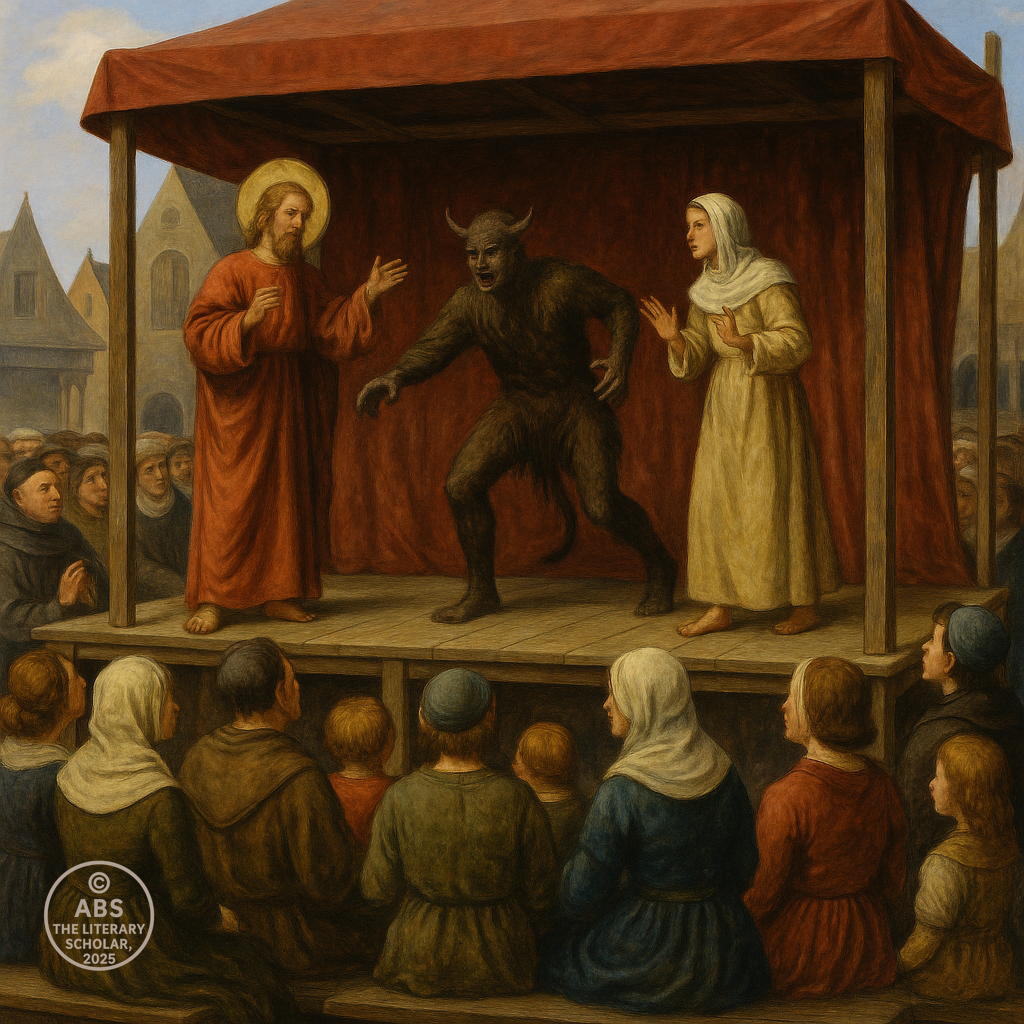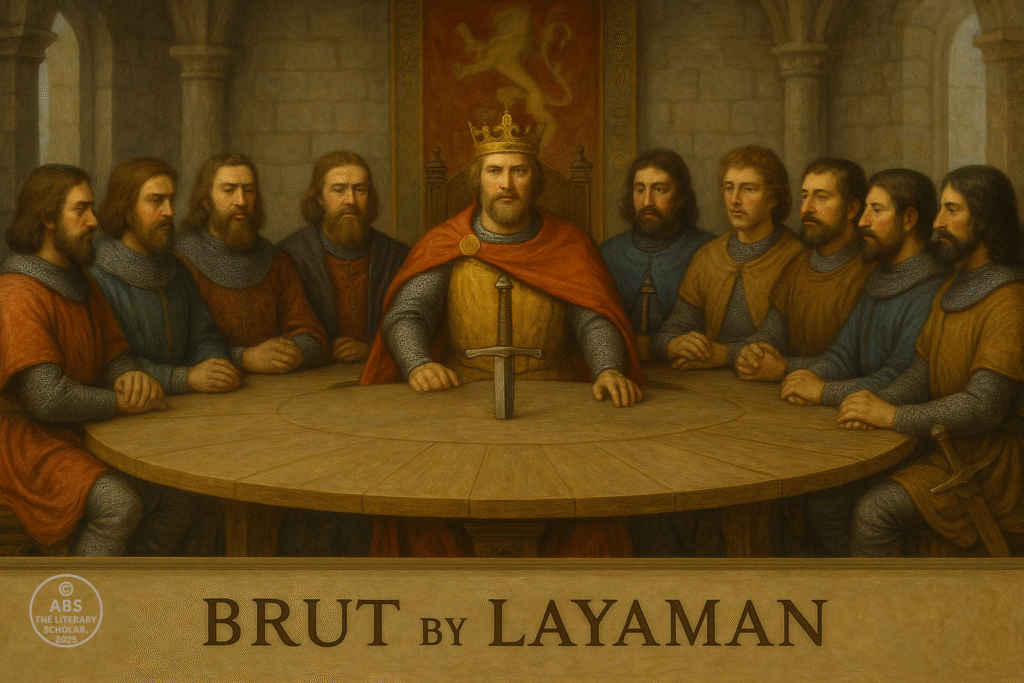From The Professor's Desk
Introduction to the Middle English Period (1066–1480)
The Middle English period marks one of the most profound transitions in the history of the English language and its literature. The year 1066 stands as a watershed — the Norman Conquest led by William of Normandy altered the linguistic, political, and cultural landscape of England. Anglo-Saxon rule gave way to Norman aristocracy, and with it came a fusion of languages, values, and literary impulses. The old Germanic-rooted Old English began absorbing Norman French influences, gradually transforming into a more flexible Middle English. It was not merely the language that evolved; the very consciousness of the nation, its class structures, religious expressions, and literary imagination underwent deep change. This was the era when Latin remained the tongue of the Church, French of the court, and English — though pushed to the margins — began a slow and inexorable climb to literary prominence.
From the 12th to the 15th century, English literature blossomed into new forms, voices, and visions. The religious fervour of Miracle, Morality, and Mystery Plays resonated with the common folk, while allegorical and chivalric romances found favour with the gentry. A remarkable array of authors — from the anonymous Pearl Poet to Julian of Norwich, William Langland, and John Gower — expanded the expressive possibilities of Middle English. Above all, Geoffrey Chaucer stood as the literary giant of the age, crafting The Canterbury Tales, a monumental work that immortalised the diversity of English society and signalled the dawn of a more self-aware English literary tradition. As the period closed, shadowed by the Hundred Years’ War, Peasants’ Revolt, Black Death, and religious reform stirrings, English literature had acquired a rich complexity — setting the stage for the intellectual efflorescence of the Renaissance to come.
From The Professor's Desk
Transition and Linguistic-Cultural Transformation (1066–1200)”
The Norman Conquest of 1066 was not merely a military victory — it was an event that profoundly reshaped the linguistic and cultural identity of England. When William, Duke of Normandy, claimed the English crown, he also brought with him a new language of power — Norman French — and a new cultural sensibility that would, over time, permeate the English court, the Church, and the law. For nearly two centuries following the Conquest, England became a land of three tongues: Latin for the Church and learning, French for the aristocracy and administration, and English for the common folk.
This period of linguistic tension and cultural negotiation gave birth to Middle English — an emergent, adaptive language forged through contact and necessity. The old inflectional system of Old English weakened, French vocabulary seeped into every domain of life, and new syntactic forms evolved. The literary record of these years, though sparse, provides glimpses of this transformation: legal documents began to appear in a hybrid vernacular; the Ormulum sought to stabilise spelling and pronunciation; the Peterborough Chronicle recorded the changing tongue in prose. In monasteries and manor houses alike, a new linguistic consciousness was stirring — one that would, in time, enable English to reclaim its place as a literary language of power and subtlety.
The cultural effects of the Norman presence were equally profound. Feudal values, chivalric ideals, and continental artistic forms were imported and gradually integrated into English society. Architecture soared into new Gothic forms; manuscript illumination reflected continental styles; and courtly literature introduced new themes of honour, love, and fate. Yet throughout this period, native English resilience endured — in the oral traditions of ballads, in local religious practices, and in the evolving speech of everyday people. The story of this era is not one of cultural replacement, but of dynamic synthesis — a transformation that would lay the foundations for the literary flowering of later centuries.

The Norman Conquest
The Norman Conquest refers to the invasion and subsequent conquest of England by William the Conqueror, Duke of Normandy, in 1066. This event had profound and lasting effects on English history, culture, and society. Here are the key details of the Norman Conquest:
Background:
Edward the Confessor: The death of King Edward the Confessor in 1066 without a clear heir set the stage for a power struggle over the English throne.
Claimants to the Throne: Three main claimants emerged: Harold Godwinson, an English noble; Harald Hardrada, King of Norway; and William, Duke of Normandy.
Invasion and Battle of Hastings:
Harold Godwinson: After Harold Godwinson was crowned as King of England, William of Normandy, also known as William the Conqueror, launched an invasion to assert his claim to the throne.
Battle of Hastings (1066): The decisive clash occurred on October 14, 1066, at the Battle of Hastings. Harold’s forces were defeated, and he was killed in the battle.
Results and Impact:
Norman Rule: William was crowned King of England and became known as William I or William the Conqueror. The Normans established a new ruling elite in England.
Feudal System: The Normans introduced a more centralized feudal system, with the king as the ultimate landowner and vassals holding land in exchange for military service.
Domesday Book: William ordered a survey of England’s landholdings, known as the Domesday Book, to assess taxation and strengthen royal control.
Language and Culture: The Norman Conquest led to the infusion of Norman French into the English language, creating Middle English. It also brought Norman-style architecture and cultural influences.
Legal Changes: The Normans introduced new legal concepts and established a more centralized legal system. The English legal system evolved, blending Norman and Anglo-Saxon elements.
Church and Monastic Reform: The Normans exerted control over the Church, leading to monastic reform and closer ties between the English Church and the papacy.
Nobility and Land Ownership: The Norman nobility held extensive lands, leading to the development of castles and fortifications across the countryside.
End of Anglo-Saxon Era: The Norman Conquest marked the end of the Anglo-Saxon era and the beginning of Norman rule, which would shape English history for centuries.
William of Normandy
(William the Conqueror):
Duke of Normandy,
The Norman Conquest was a pivotal event that reshaped England’s political, social, and cultural landscape. It brought together Norman and Anglo-Saxon elements, resulting in a unique blend that would eventually contribute to the formation of modern English identity.
The Battle of Hastings, which occurred on October 14, 1066, was a pivotal event in English history that resulted in the Norman Conquest of England. It took place near the town of Hastings in East Sussex, England, and marked the culmination of a power struggle for the English throne following the death of King Edward the Confessor. Here are the key details of the Battle of Hastings:
Succession Crisis: The death of King Edward the Confessor in January 1066 left England without a clear heir to the throne. Several claimants emerged, including Harold Godwinson, William of Normandy, and Harald Hardrada of Norway.
Claimants:
Harold Godwinson: An English nobleman and Edward’s brother-in-law, Harold was crowned as King of England shortly after Edward’s death.
William of Normandy (William the Conqueror): Duke of Normandy, William claimed that Edward had promised him the English throne. When Harold assumed the throne, William saw this as a breach of the alleged promise.
Harald Hardrada: King of Norway, he also claimed the English throne.
Invasion by Harald Hardrada:
In September 1066, Harald Hardrada invaded England, hoping to seize the throne. He achieved an initial victory at the Battle of Fulford against English forces led by Earl Edwin and Earl Morcar. However, Harold Godwinson quickly gathered his forces and marched north to confront the Norwegian invasion.
Battle of Stamford Bridge:
On September 25, 1066, Harold’s forces defeated Harald Hardrada’s forces at the Battle of Stamford Bridge in Yorkshire. Hardrada and his ally, Tostig Godwinson (Harold’s brother), were killed in the battle.
William’s Invasion:
While Harold was dealing with the Norwegian invasion, William of Normandy launched his own invasion of England. He assembled a fleet of ships and an army, including cavalry, archers, and infantry.
The Battle of Hastings:
On October 14, 1066, Harold’s forces faced William’s Normans at the Battle of Hastings. The battle was fierce and lasted throughout the day. Harold’s army formed a shield wall to protect against the Norman cavalry charges.
Arrow in the Eye:
Legend has it that Harold Godwinson was fatally struck in the eye by an arrow during the battle. This led to his death and a collapse of morale among his troops.
Norman Victory:
With the death of Harold, the English forces were eventually overcome by the Normans. William emerged victorious, securing his claim to the English throne.
William the Conqueror was crowned King of England on Christmas Day in 1066. His victory marked the beginning of Norman rule in England and the subsequent integration of Norman and Anglo-Saxon cultures. The Norman Conquest had a profound impact on English society, language, culture, and governance.
The Battle of Hastings remains one of the most important events in English history, shaping the course of the nation for centuries to come.

The Middle English period (c. 1100-1500)
The Middle English period (c. 1100-1500) is the era that followed the Norman Conquest of England in 1066. It was a time of significant linguistic, cultural, and social change, marked by the fusion of Old English (Anglo-Saxon) and Norman French influences. Here’s how the Norman Conquest relates to the Middle English period:
Linguistic Transformation:
The Norman Conquest had a profound impact on the English language. Norman French became the language of the ruling elite, and Old English was gradually marginalized. However, as time passed, the English and Norman populations began to intermingle and interact. This interaction led to the emergence of Middle English, a language that combined elements of both Old English and Norman French. The linguistic fusion of these two languages gave birth to Middle English, characterized by changes in vocabulary, grammar, and pronunciation.
Cultural Exchange and Integration
The Normans brought their own cultural practices, architecture, legal systems, and societal norms to England. These Norman influences mixed with existing Anglo-Saxon traditions, resulting in a unique blend of cultures. Over time, the cultural integration of the Normans and Anglo-Saxons gave rise to a distinct English identity that drew from both traditions. This cultural amalgamation can be seen in various aspects of medieval literature, art, and architecture.
Literary Evolution:
The Norman Conquest brought changes to the literary landscape of England. Initially, much of the literature was produced in Latin and was influenced by Continental traditions. As Middle English developed, literature began to be written in the vernacular, reflecting the linguistic changes of the time. Prominent literary works from the Middle English period, such as “Sir Gawain and the Green Knight” and Geoffrey Chaucer’s “Canterbury Tales,” reflect the blending of Norman and English cultural elements.
Social and Political Structure
The Norman Conquest led to significant changes in the social and political structure of England. The Normans introduced a more centralized feudal system, with the king at the top of the hierarchy. Norman nobles held extensive lands, and castles and fortifications became prevalent features of the landscape. The division between the Norman aristocracy and the Anglo-Saxon population also played a role in shaping societal norms and power dynamics during the Middle English period.
In summary, the Norman Conquest of 1066 marked a pivotal moment in English history that had far-reaching effects on language, culture, and society. The Middle English period that followed saw the gradual integration of Norman and Anglo-Saxon elements, leading to the emergence of a distinctive Middle English language and culture. This period laid the groundwork for the rich literary and cultural achievements that would follow in subsequent centuries.
The Middle English period of English literature spans from around the 12th century to the 15th century.
It follows the Old English period and precedes the Early Modern English period. This era saw significant changes in the English language, society, and culture, and it produced some remarkable literary works that continue to be influential to this day
The Middle English period was a time of great cultural transformation in England. It began with the Norman Conquest of 1066, which brought French influences to the English language and introduced French as the language of the court and the nobility. Over time, English and French languages merged, resulting in Middle English, a language more recognizable to modern English speakers.
The period was marked by social, political, and religious upheavals, including the rise of the middle class and the power of the church. Literature during this time reflected these changes and began to shift from the heroic themes of the Old English period to more diverse topics, including romance, allegory, and religious narratives.
Characteristics:
Vernacular Literature: Middle English literature was predominantly written in the vernacular language, making it more accessible to a wider audience than the Latin-dominated literature of the earlier periods.
Romance and Courtly Love: The Middle English period saw the flourishing of romance literature, often dealing with themes of chivalry, courtly love, and adventure. These romances typically featured knights, damsels in distress, and quests for love and honor.
Allegory and Moral Tales: Allegorical works became popular during this time, using symbolic characters and settings to convey moral and religious lessons. Popular allegorical works include “The Divine Comedy” by Dante Alighieri and “Piers Plowman” by William Langland.
Religious Literature: The Middle English period witnessed a significant amount of religious literature, including biblical translations, saints’ lives, and devotional writings.
Drama: Early forms of English drama began to emerge during the later part of the Middle English period, with the development of mystery plays and morality plays performed by guilds and religious institutions.
Miracle, Morality, and Mystery plays
Miracle, Morality, and Mystery plays are three types of medieval English drama that were popular during the Middle Ages. Each type had its distinctive characteristics and served different purposes in the religious and cultural life of the time.
Miracle Plays:
Miracle plays, also known as Saints’ plays or Corpus Christi plays, were dramatic representations of the lives, miracles, and martyrdom of saints. These plays were performed as part of religious festivals and celebrations in medieval England.
Miracle plays aimed to instruct and entertain the largely illiterate population about religious stories and events. They were performed in churches, town squares, or other public spaces.
The plays often featured religious figures, such as biblical characters, angels, and saints, and they dramatized events like the Nativity, Crucifixion, and Resurrection of Jesus Christ.
One of the most famous Miracle plays is the “The Second Shepherd’s Play,” which depicts the Nativity story with a touch of humor.
Morality Plays:
Morality plays were allegorical dramas that personified abstract virtues and vices to depict the struggle between good and evil and the choices individuals face in their lives.
These plays were didactic in nature, aiming to teach moral lessons and instruct the audience on the importance of leading virtuous lives.
The characters in Morality plays often had names that represented their qualities, such as Everyman, Good Deeds, Knowledge, and Death.
One well-known Morality play is “Everyman,” which follows the journey of the main character Everyman as he faces his own mortality and seeks salvation.
Mystery Plays:
Mystery plays were religious dramas that dramatized stories from the Bible, particularly those relating to the life and teachings of Jesus Christ.
Mystery plays were performed by trade guilds or craft associations as part of religious festivals and processions. Each guild would be responsible for producing and performing a specific play.
The word “mystery” in this context comes from the Latin “mysterium,” meaning “occupation” or “craft,” as each guild focused on a specific aspect of the religious narrative.
Mystery plays were often performed in cycles, where a series of plays would cover the entire biblical history, from the creation of the world to the Last Judgment.
The “York Mystery Plays” and the “Wakefield Mystery Plays” are two examples of well-known cycles of Mystery plays.
These types of plays were an integral part of medieval English drama and played a significant role in religious education and community cohesion. They brought together people from all walks of life, entertaining and enlightening audiences while conveying important moral and religious messages. The performance of these plays also contributed to the development of theatrical traditions and the emergence of professional theater in later periods.

Middle English Period Authors and Poets
Geoffrey Chaucer (c. 1343-1400):
“The Canterbury Tales”: A collection of stories told by a diverse group of pilgrims traveling to Canterbury Cathedral. Each tale offers a glimpse into the lives and values of people from various social backgrounds, reflecting the diverse society of medieval England.
Sir Gawain Poet (Anonymous):
“Sir Gawain and the Green Knight”: This medieval romance follows the adventures of Sir Gawain, a knight of King Arthur’s Round Table. Gawain accepts a challenge from a mysterious Green Knight and embarks on a quest that tests his courage and honor.
William Langland (c. 1332-c. 1386):
“Piers Plowman”: An allegorical and visionary narrative, “Piers Plowman” explores the quest for a Christian life and true faith. The dreamer, Will, seeks spiritual truth through various allegorical characters and visions.
Julian of Norwich (c. 1342-c. 1416):
“Revelations of Divine Love”: A profound work on religious visions and reflections on God’s love and compassion. Julian’s writings explore her mystical experiences and the profound insights into the nature of divine grace.
John Gower (c. 1330-1408):
“Confessio Amantis”: A long poem in which a lover confesses his sins to the god of love, Venus. The poem comprises various tales from different cultures and moral lessons delivered through allegory.
Pearl Poet (Anonymous):
“Pearl”: A dream vision poem in which the narrator mourns the loss of a young daughter named Pearl. The poem explores themes of grief, divine love, and the search for spiritual understanding.
Margery Kempe (c. 1373-c. 1438):
“The Book of Margery Kempe”: One of the earliest autobiographies in English, this work records the spiritual experiences and religious visions of Margery Kempe, a mystic and anchoress.
Anonymous Mystery Plays:
“The Wakefield Mystery Plays” and “The York Mystery Plays”: These plays, performed by guilds and religious institutions, depict biblical stories and the life of Christ, aiming to teach moral and religious lessons to the medieval audience.
“The Vision of William Concerning Piers Plowman”:
An expanded version of “Piers Plowman” by William Langland, this work continues to explore the allegorical quest for spiritual truth and righteousness through the character of Piers Plowman.
“The York Cycle”:
A collection of 48 medieval mystery plays performed in the city of York. The cycle covers a wide range of biblical stories, from the creation of the world to the Last Judgment.
These works from the Middle English period represent a rich tapestry of literature that reflects the religious, moral, and societal concerns of medieval England. They offer valuable insights into the beliefs, values, and struggles of the people of that time and continue to be studied and appreciated for their literary and historical significance.
LAYAMON
Layamon lived during the late 12th century. His exact dates are not well-documented, but he is generally believed to have composed his work “Brut” around the years 1190 to 1215. This places him in the historical period of the late 12th and early 13th centuries, a time when the Norman Conquest had already taken place, and England was experiencing cultural and linguistic changes.
During Layamon’s time, the English language was undergoing a transition from Old English to Middle English. The Norman Conquest of England in 1066 by William the Conqueror had a significant impact on the linguistic landscape of the country, as Norman French became the language of the ruling elite, while Old English continued to be spoken by the common people. This linguistic interaction eventually contributed to the development of Middle English, which was characterized by a mixture of Old English, Norman French, and Latin influences.
“Brut,” written by Layamon, is a significant Middle English work that blends historical and legendary elements to retell the history of Britain. Created in the late 12th century, “Brut” draws upon earlier sources, particularly Geoffrey of Monmouth’s “Historia Regum Britanniae,” while also incorporating Layamon’s unique style and linguistic adaptations.
“Brut” by Layamon:
Historical and Legendary Fusion: “Brut” combines historical accounts with legendary narratives, tracing the lineage of the British people from their supposed Trojan origins through the reigns of legendary kings and events like King Arthur’s court and the Round Table.
Heroic Themes: The poem emphasizes the heroic and chivalric deeds of legendary characters, portraying them as larger-than-life figures who embody qualities of honor, bravery, and nobility.
King Arthur and the Round Table: “Brut” includes a notable emphasis on King Arthur and the Knights of the Round Table. These figures are depicted in romanticized and idealized terms, embodying the
ideals of medieval chivalry.
Alliterative Verse: Layamon employs the traditional style of alliterative verse, echoing the poetic forms of Old English poetry. This form lends a rhythmic and musical quality to the narrative.
Linguistic Transition: The poem is a valuable linguistic resource, showcasing the transition from Old English to Middle English. Layamon’s adaptation of earlier material offers insight into the evolving English language.
National Identity: “Brut” contributes to the development of a distinct British identity by connecting the legendary past of the island with its historical and cultural heritage.
Influence of Geoffrey of Monmouth: Layamon’s work is influenced by Geoffrey of Monmouth’s “Historia Regum Britanniae,” but Layamon adapts and reinterprets the material to suit his own narrative goals.
Manuscripts: The poem survives in two main manuscripts, Cotton Caligula A. ix and Cotton Otho C. xiii, each containing variations in language, dialect, and content.
Layamon’s “Brut” exemplifies the medieval fascination with historical narratives, heroic legends, and the shaping of national identity. Through its blend of history and legend, it bridges the Old English and Middle English literary traditions and contributes to the ongoing evolution of the English language and cultural consciousness.

The first chapter of the Middle English period reveals a truth that every student of literature must remember: language lives, breathes, and transforms with history. The Norman Conquest did not silence English — it reshaped it, enriched it, and prepared it for a broader literary destiny. What emerged was not loss, but renewal — a testament to the enduring strength of a living tongue.
The transition from Old English to Middle English was not a rupture, but a remarkable evolution. Shaped by conquest, contact, and adaptation, the English language emerged more resilient, capable of carrying the intellectual and imaginative currents of the coming age. As we now move forward into the literature of the later Middle English period, we do so with an appreciation for the linguistic and cultural foundations laid during these formative years.
From the Professor’s Desk
ABS, The Literary Professor
From The Professor's Desk
Share this post / Spread the witty word / Let the echo wander / Bookmark the brilliance
